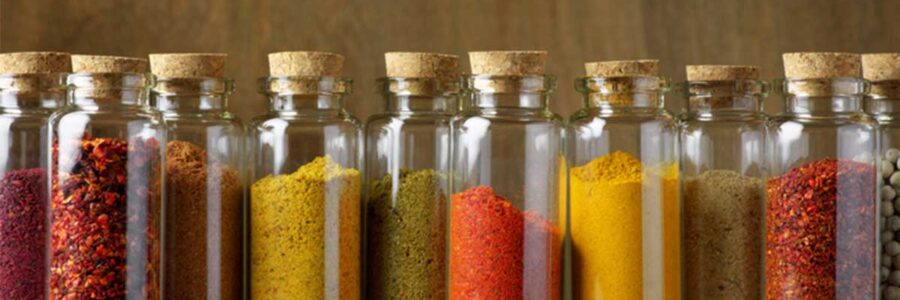Household Spices are a common addition to our meals, enhancing flavors and adding variety to our cooking. However, a hidden danger may be lurking in our kitchen pantries. Surprisingly, many spices harbor unsafe levels of heavy metals, including lead and arsenic, which can pose significant health risks.[1]
A comprehensive study conducted by Consumer Reports examined 126 spice products and identified alarming levels of heavy metal contamination in 40 of them.[1] This article explores the dangers of heavy metal exposure, the spices found to be problematic, and the sources of contamination. It provides practical steps to ensure the safety of herbs in your kitchen.
The Dangers of Heavy Metal Exposure
Heavy metals are toxic substances the human body cannot effectively eliminate or break down.[2] This leads to their accumulation, which can interfere with crucial physiological functions. Of particular concern is the impact of lead exposure on children’s development. Lead has been linked to behavioral problems and lower IQ in children, as it disrupts brain development.[3] In adults, lead exposure can cause central nervous system issues, reproductive problems, hypertension, kidney damage, and impaired immune function.[4]
Identifying Problematic Spices
Consumer Reports conducted a meticulous testing strategy, analyzing samples of 126 spice products from 38 brands.[1] The results were categorized into four levels: no concern, some concern, moderate concern, and high concern. Spices such as La Flor Ground Oregano, La Flor Ground Turmeric, Happy Belly Ground Thyme, Spice Islands Sweet Basil, and Tone’s Ground Thyme were identified as moderate or high concern. Additionally, 35 other spices showed varying levels of concern regarding lead content.[1]
Consistently problematic spices included basil (except Simply Organic), ginger (except Simply Organic), oregano, and thyme. On the other hand, spices like black pepper, coriander, curry powder, garlic powder, saffron, sesame seed, and white pepper demonstrated little to no issues.[1]
The Roots of Contamination
Several factors contribute to the contamination of spices with heavy metals. Firstly, plants can absorb lead from the soil and groundwater where they grow. Secondly, contamination can occur during the processing of spices on factory machinery. Finally, some manufacturers, particularly those outside the United States, may intentionally add lead to enhance color, reminiscent of historical use in paints and pigments.[1]
Safeguarding Your Kitchen: Ensuring Safe Spices
Preventive Measures
In light of the study’s findings, consumers must cautiously approach spice selection. Spices consistently showing contamination, such as basil and oregano, should be used sparingly if safe alternatives cannot be sourced.
Consumer Reports suggests growing your herbs and spices to guarantee their safety. In addition, the Center for Agriculture, Food, and Environment at the University of Massachusetts provides guidelines on reducing lead exposure in gardening to grow safer produce.[5]
Growing Your Spices: Reducing Lead Exposure
Guidelines for growing safer produce include locating gardens away from old painted structures and heavily trafficked roads, prioritizing fruiting crops, incorporating organic materials into the soil, and maintaining a soil pH of 6.5 to 7.0 to minimize lead availability.[5] Additionally, practicing good hygiene by washing hands after gardening and before eating, removing outer leaves from leafy vegetables, peeling root crops, and washing all produce thoroughly can reduce lead exposure.
Measures such as using a fence or hedge to protect the garden from airborne particulates, minimizing dust, and maintaining a well-mulched, vegetated, or moist soil surface can further safeguard against contamination. To determine the heavy metal content in your soil, simple soiltest kits are available for analysis.
Making Informed Decisions: Shopping for Safer Spices
When shopping for spices, consumers should be discerning and informed about potential contamination. It is advisable to avoid brands and products that have been identified with problematic heavy metal levels whenever possible.
Choosing certified organic products can be beneficial, as they generally undergo more rigorous testing and have stricter regulations regarding contamination. However, it is important to note that “organic” does not guarantee “heavy metal-free”.[6] Therefore, diversifying spice brands and sources can help mitigate the risk of heavy metal exposure.
Summary: Ensuring a Healthier Kitchen
Heavy metals in common household spices are a concerning issue that demands attention. The study by Consumer Reports identified numerous spices with troubling levels of heavy metal contamination, particularly lead, which poses significant health risks. Regular consumption of even small amounts of these toxins can lead to their accumulation in the body and interfere with various physiological functions. Children are especially vulnerable, as lead exposure can impair brain development and cause behavioral issues.
Contamination primarily occurs through the absorption of heavy metals from soil and groundwater by plants, as well as during processing or deliberate addition by certain manufacturers. To ensure a healthier kitchen, it is essential to be selective when purchasing spices, use problematic spices sparingly, and consider growing your own herbs and spices using recommended guidelines to reduce In addition, testing exposure. Testing soil for heavy metals and following good hygiene practices further contribute to a safer kitchen environment.
By taking these proactive measures, individuals can safeguard themselves and their families, minimizing the risk of heavy metal exposure and promoting a healthier life.
References:
- Gill, Lisa L. “Your Herbs and Spices Might Contain Arsenic, Cadmium, and Lead.” Consumer Reports,www.consumerreports.org/health/food-safety/your-herbs-and-spices-might-contain-arsenic-cadmium-and-lead-a6246621494/.
- Jaishankar, Monisha et al. “Toxicity, mechanism and health effects of some heavy metals.” Interdisciplinary toxicology vol. 7,2 (2014): 60-72. doi:10.2478/intox-2014-0009
- Sanders, Talia, et al. “Neurotoxic effects and biomarkers of lead exposure: a review.” Reviews on environmental health vol. 24,1 (2009): 15-45. doi:10.1515/reveh.2009.24.1.15
- “Lead Poisoning.” World Health Organization,www.who.int/news-room/fact-sheets/detail/lead-poisoning-and-health.
- “Soil Lead Fact Sheet.” Center for Agriculture, Food, and the Environment, 31 Mar. 2020, ag.umass.edu/soil-plant-nutrient-testing-laboratory/fact-sheets/soil-lead-fact-sheet.
- ConsumerLab.com. “USDA Organic Seal & Heavy Metal Testing in Supplements.” ConsumerLab.Com, 12 Aug. 2022,www.consumerlab.com/answers/usda-organic-seal-on-supplements-heavy-metals/usda-organic-seal/.


